Hospital organizational charts play a crucial role in ensuring effective hospital management. By revealing organizational leadership, defining the responsibilities of the board of directors, and facilitating communication, these charts enhance the overall efficiency and coordination within the hospital.
Hospitals must prioritize creating and maintaining comprehensive and up-to-date org charts to optimize their management systems and provide quality healthcare services. In this article, you will learn everything you need to know about the hospital organizational chart.
Contents of this article
Part 1. The Importance of Hospital Organizational Charts
Organizational charts are an essential tool for establishing and maintaining an effective hospital management system. The Hospital hierarchy chart provides a clear representation of the organizational structure, roles, and responsibilities of all hospital staff members. The importance of having a well-structured and up-to-date org chart cannot be overstated.
Part 2. Benefits of a Hospital Org Chart in Hospital Management
There are several benefits of a hospital organizational chart in hospital management. It’s because of these benefits that creating an effective hospital organizational chart is important for hospital management.
- Reveals Organizational Leadership: Org charts provide a clear picture of the relationship between the hierarchy of hospital leadership.
- Highlights the Role of the Board of Directors: An organogram of the hospital helps to define the roles of the board members and their responsibilities within the hospital.
- Facilitates Effective Communication: An organogram of the hospital provides clear and concise information about who is responsible for what, which can help to streamline communication between staff members.
Part 3. Five Common Roles in Hospitals and Their Key Responsibilities
From The Board of Directors to Service Providers, there are plenty of roles in hospitals. Each of these roles has its unique responsibilities.
1. The Board of Directors
The Board of Directors serves as the governing body of a hospital, responsible for making strategic decisions and ensuring the hospital's mission and vision are upheld. Key responsibilities include setting goals and objectives, establishing policies, and providing financial oversight.
2. The Executives
The Executives, including the Chief Executive Officer (CEO), Chief Financial Officer (CFO), and Chief Medical Officer (CMO), hold key leadership positions within the hospital. Their responsibilities encompass a wide range of strategic planning, financial management, and policy development.
3. Department Managers
Department Managers are responsible for the effective functioning of specific hospital departments, such as nursing, radiology, or pharmacy. They supervise the daily operations, ensure adequate staffing, and implement policies and protocols.
4. Patient Care Managers
Patient Care Managers, often referred to as Nurse Managers or Clinical Managers play a critical role in coordinating patient care within a specific unit or department. Their responsibilities encompass overseeing nursing staff, managing patient flow, and maintaining regulatory compliance.
5. Service Providers
Service Providers, including healthcare professionals such as doctors, nurses, technicians, and therapists are the backbone of hospital operations. Their responsibilities vary depending on their field of expertise but generally involve delivering direct patient care, diagnosing and treating medical conditions, conducting tests and procedures, and offering therapeutic interventions.
Part 4. Hospital Organizational Chart Examples
Hospital organizational charts can be of various kinds. From nursing organizational charts to corporate hospital organizational charts, there are some hospital organizational chart templates.
Example 1: Hospital Organizational Chart
This organizational chart depicts a hierarchical structure, showcasing the chain of command from the Board of Directors to the various hospital departments. The Hospital Organizational Chart illustrates the relationships and reporting lines, highlighting the clear hierarchy within the hospital's administrative structure.
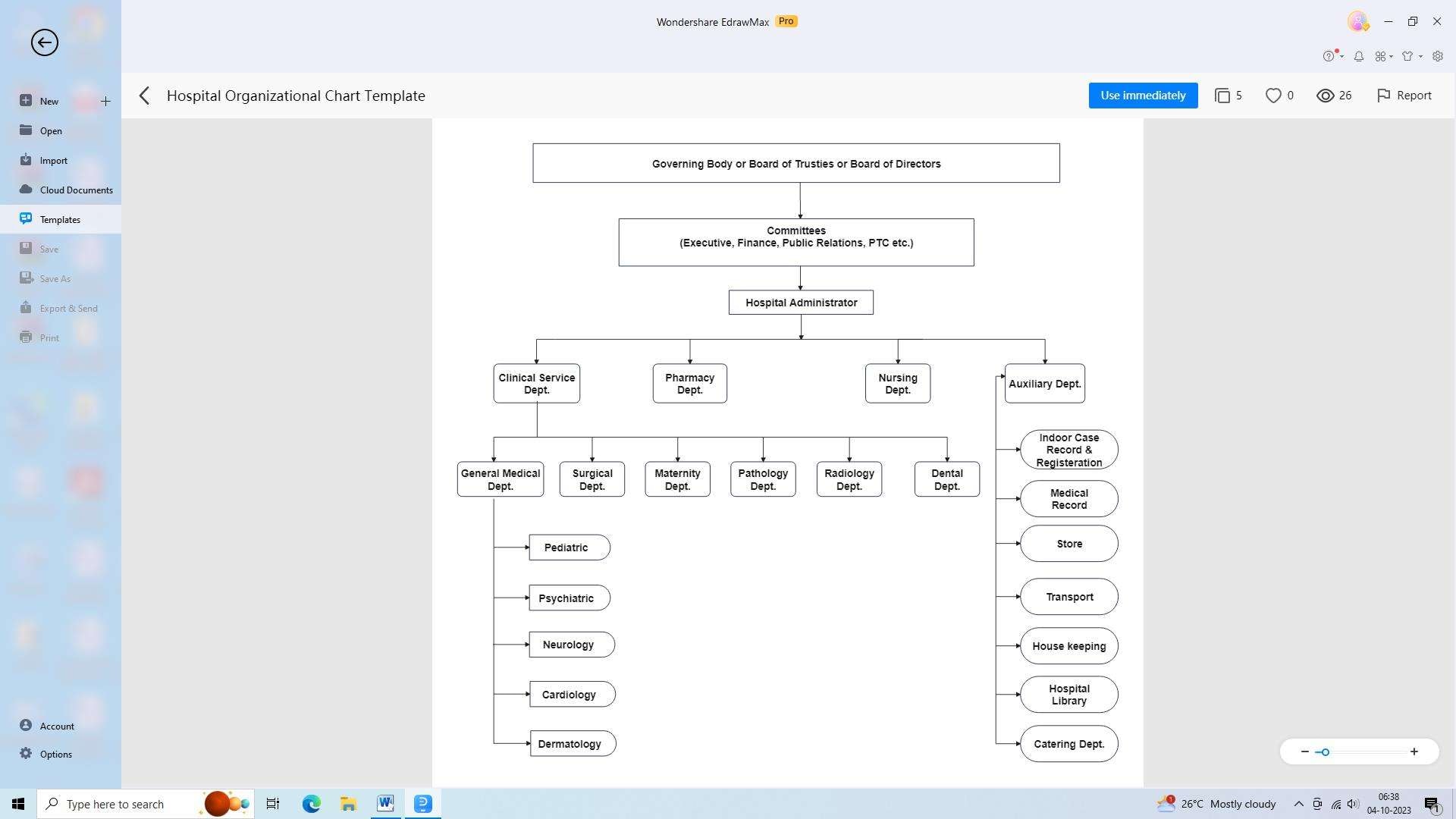
Example 2: Nursing Organizational Chart
The Nursing Organizational Chart provides a detailed overview of the hierarchical structure within the nursing department. It shows the reporting lines for Nurse Managers, charge nurses, registered nurses, and various nursing support staff.
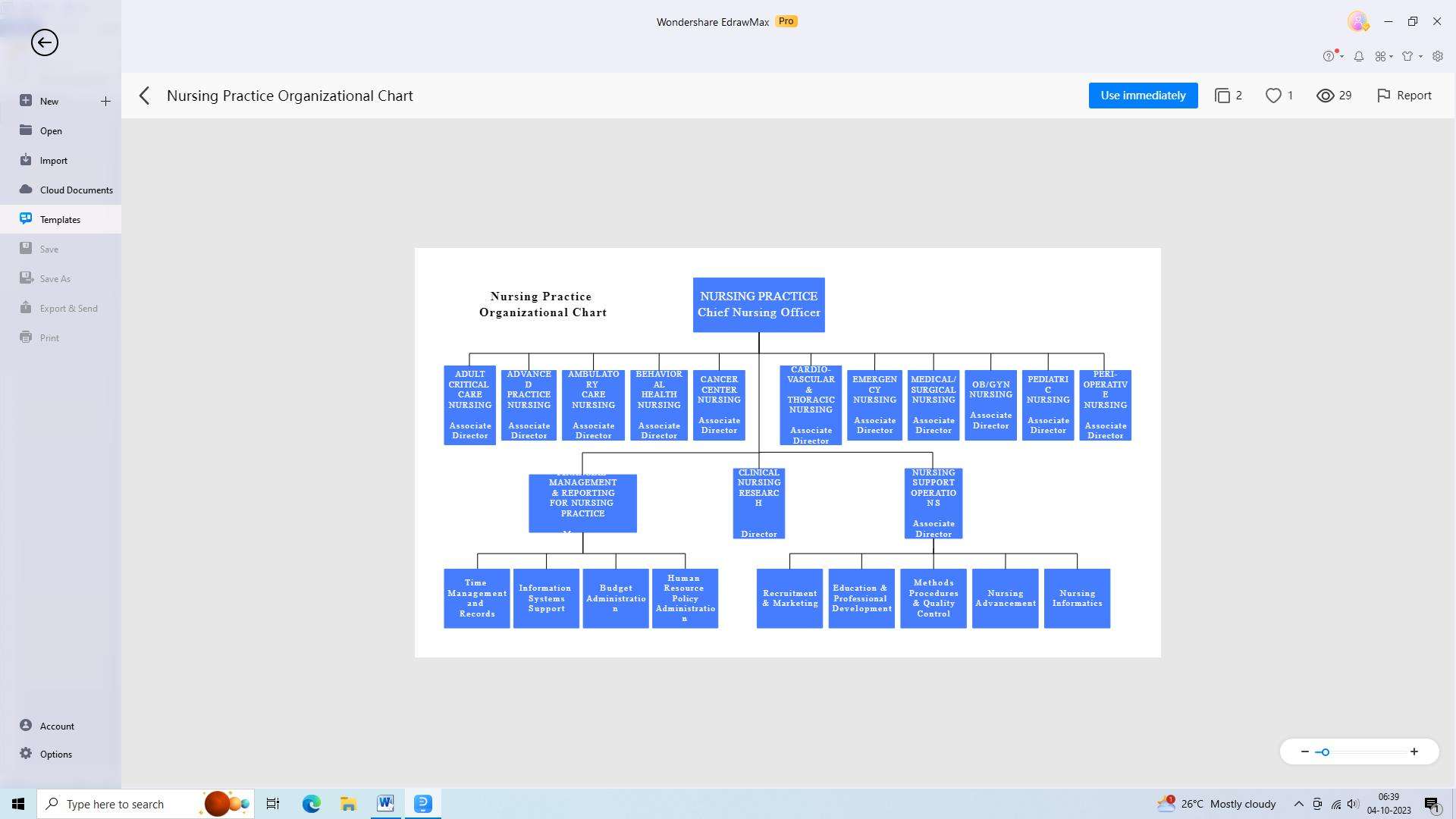
Example 3: Finance Office Organizational Chart
The Finance Office Organizational Chart outlines the hierarchical structure within the hospital's finance department. It illustrates the reporting lines for the CFO, accountants, financial analysts, and other financial personnel.
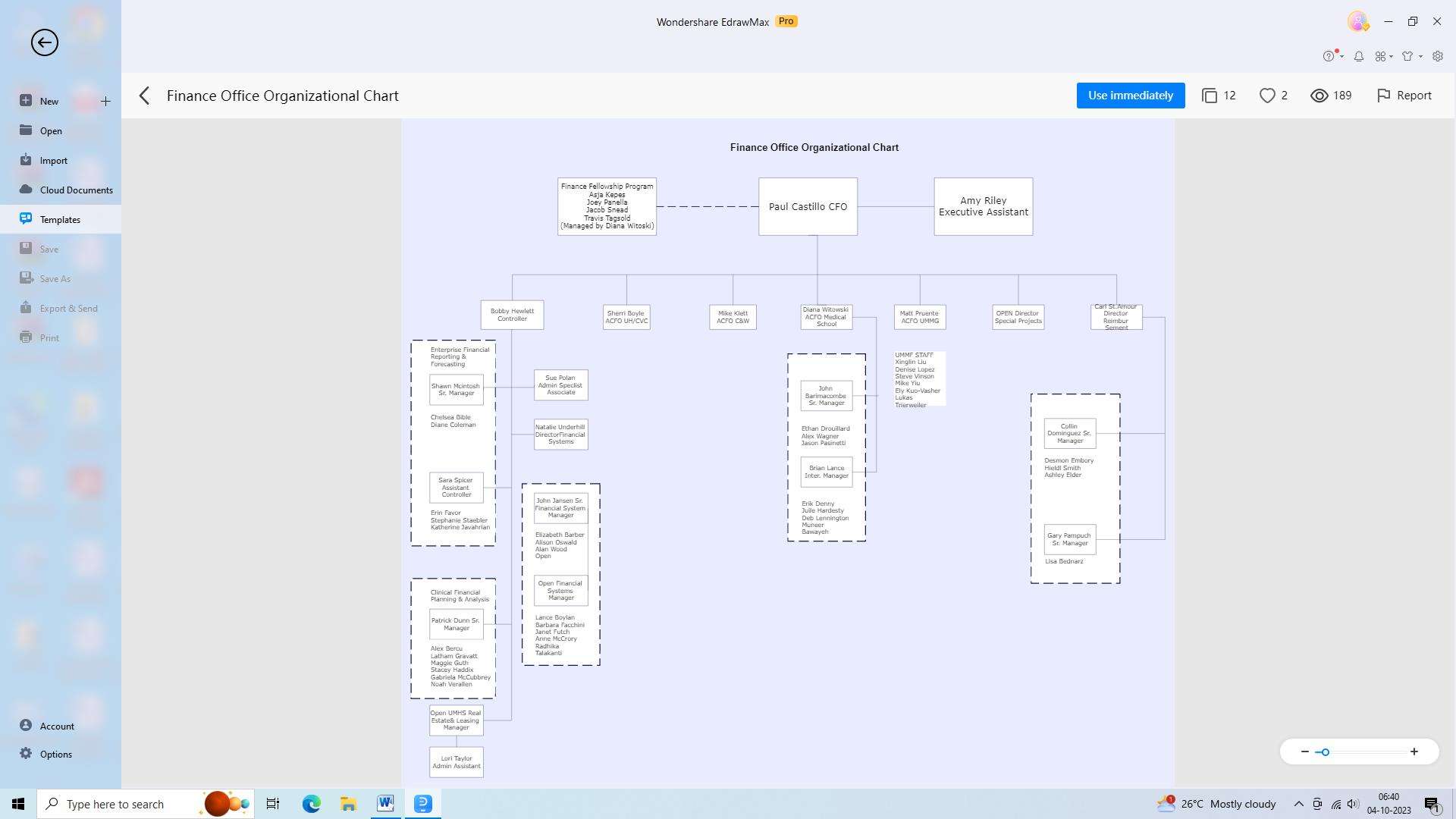
Example 4: Corporate Hospital Organizational Chart
The Corporate Hospital Organizational Chart provides a comprehensive view of the hospital's administrative structure beyond the clinical departments. The Corporate Hospital Organizational Chart showcases various administrative departments such as Human Resources, Marketing, IT, and Legal.
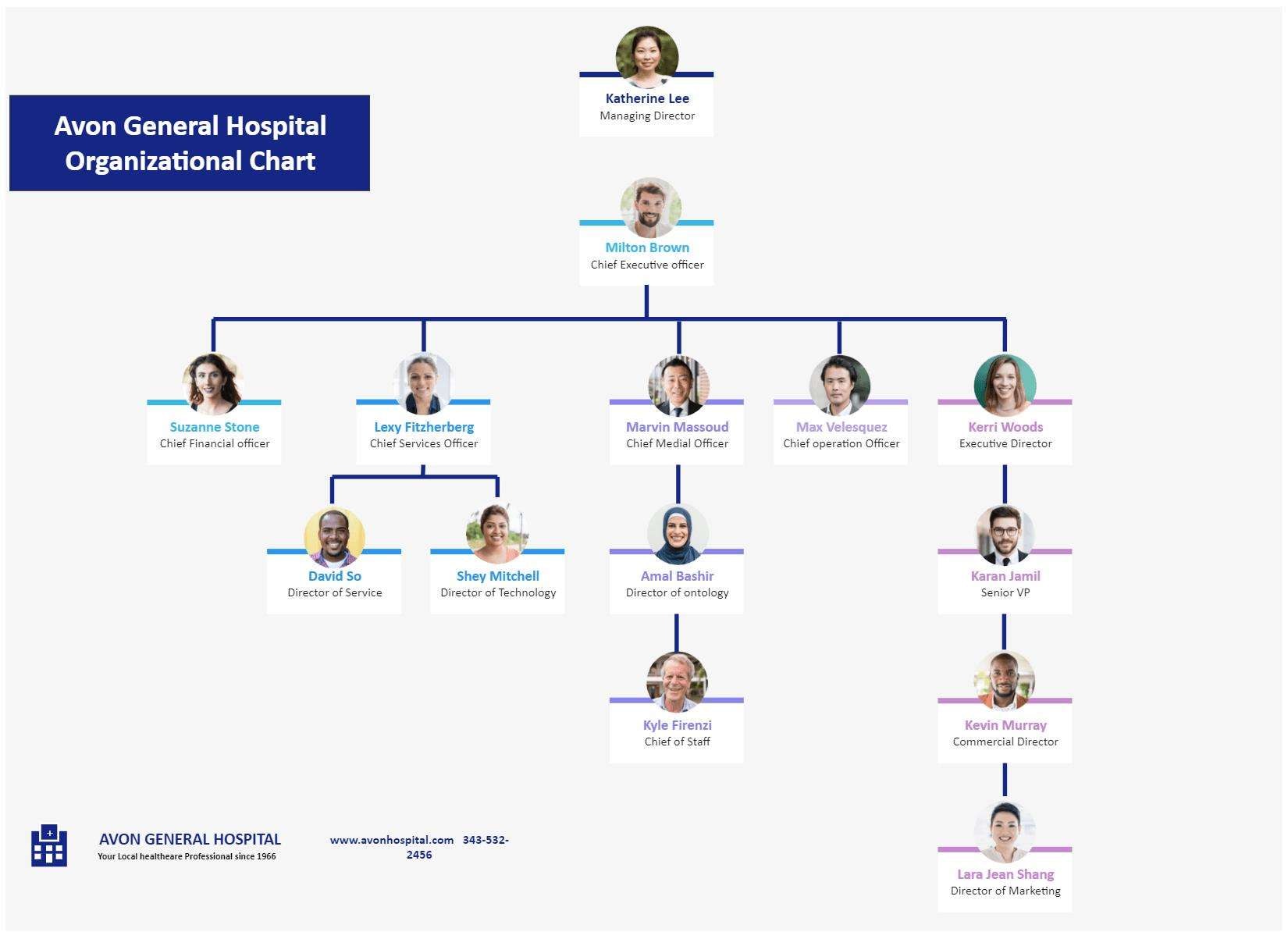
Part 5. Best Hospital Organizational Chart Maker
Creating a hospital organizational chart can be a daunting task. Fortunately, there are tools available that make it easier. We will now discuss some of the most popular hospital organizational chart-making tools.
1) Wondershare EdrawMax
Wondershare EdrawMax is a powerful org chart creation tool with a wide range of templates and symbols to create professional-looking charts. It has an intuitive interface and drag-and-drop functionality, allowing users to easily customize their charts.
Not only that, but EdrawMax also supports collaboration and sharing, making it a great choice for hospitals. Given below are the steps to create a hospital hierarchy chart using the tool:
Step 1: Login to Wondershare EdrawMax
Begin by logging in to Wondershare EdrawMax using your credentials. Ensure you have access to all the features and templates.
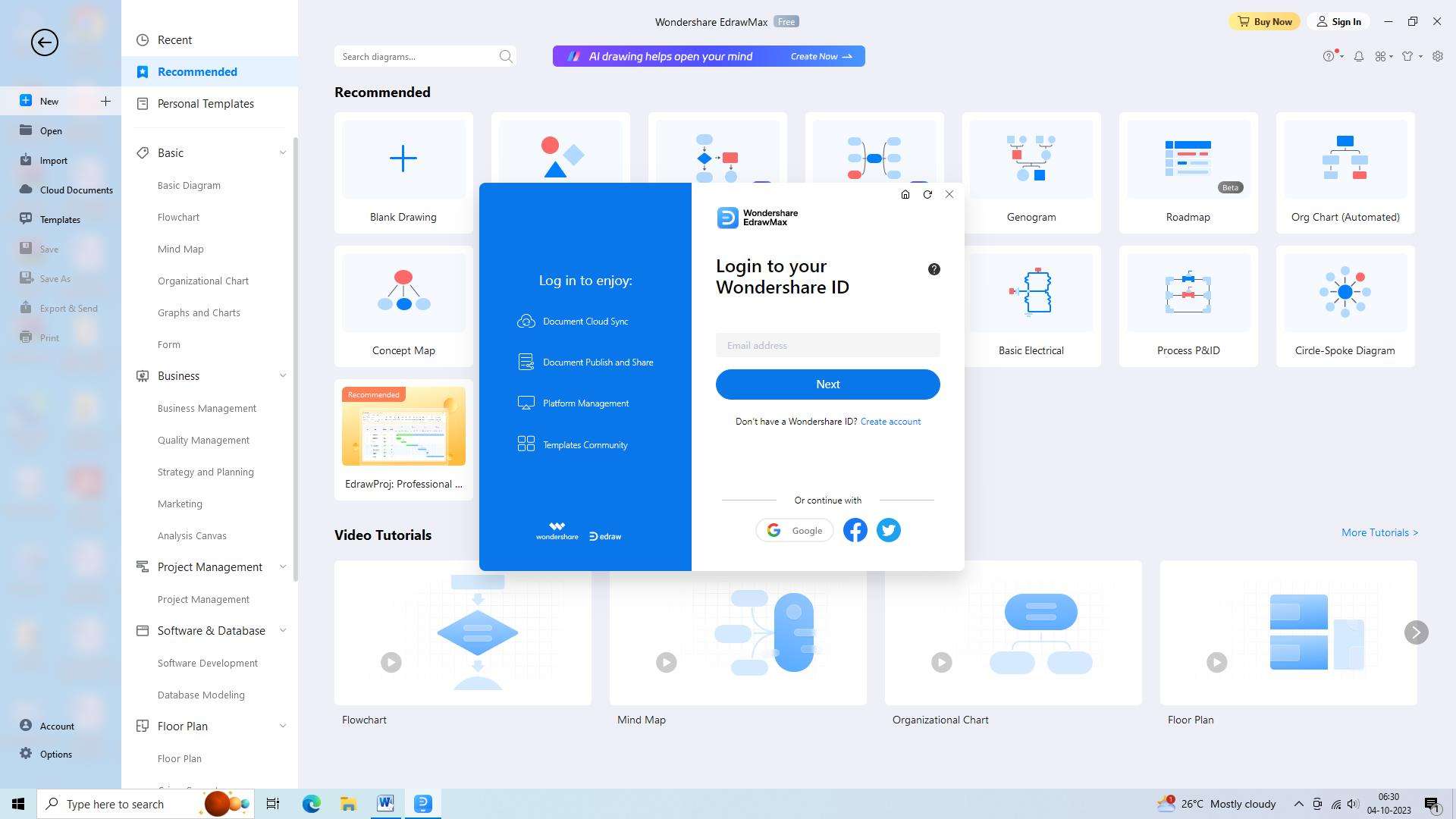
Step 2: Select "Hospital Organizational Chart" Template
Launch Wondershare EdrawMax and go to the template section, and click on the “Hospital Organizational Chart” template.

This template offers a structured layout and pre-designed shapes tailored for creating hospital organizational charts. Click on “Use Immediately” to utilize this template.
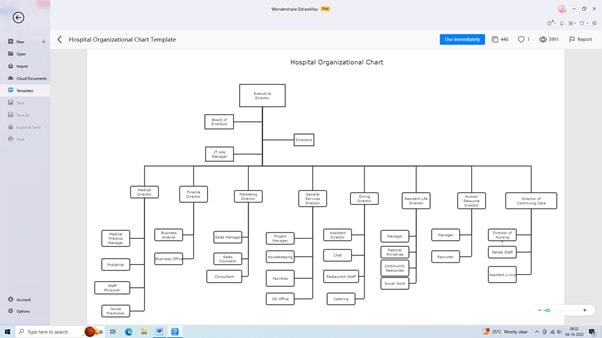
Step 3: Add Shapes and Symbols
Utilize the extensive library of shapes and symbols provided in EdrawMax. Add the necessary elements to represent departments, positions, and connections in your hospital organizational chart.
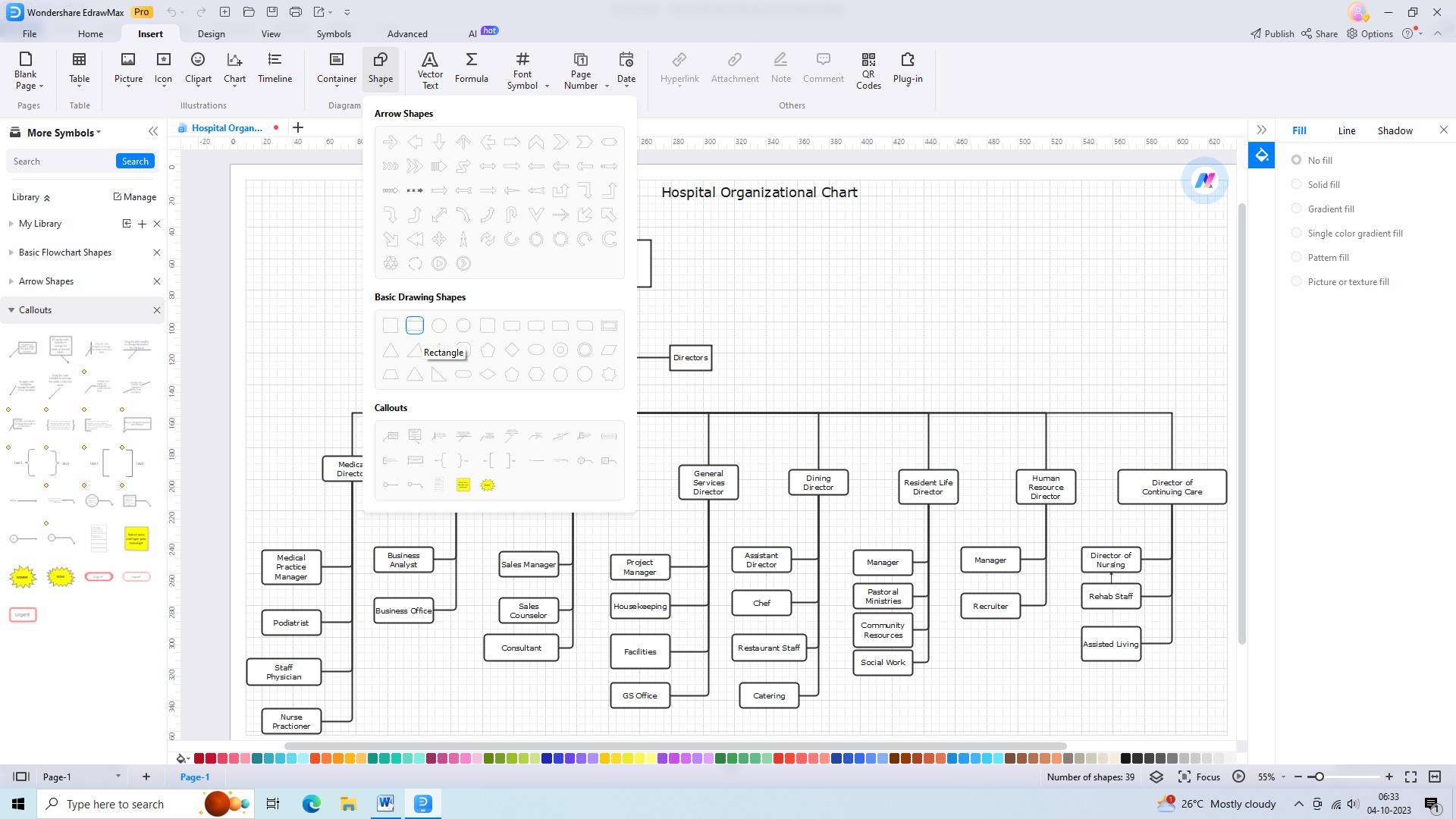
Step 4: Customize Shapes with Relevant Text
Personalize each shape by inputting relevant text. Double-click on a shape to add department names, job titles, or any other pertinent information that accurately reflects the hierarchy of your hospital.
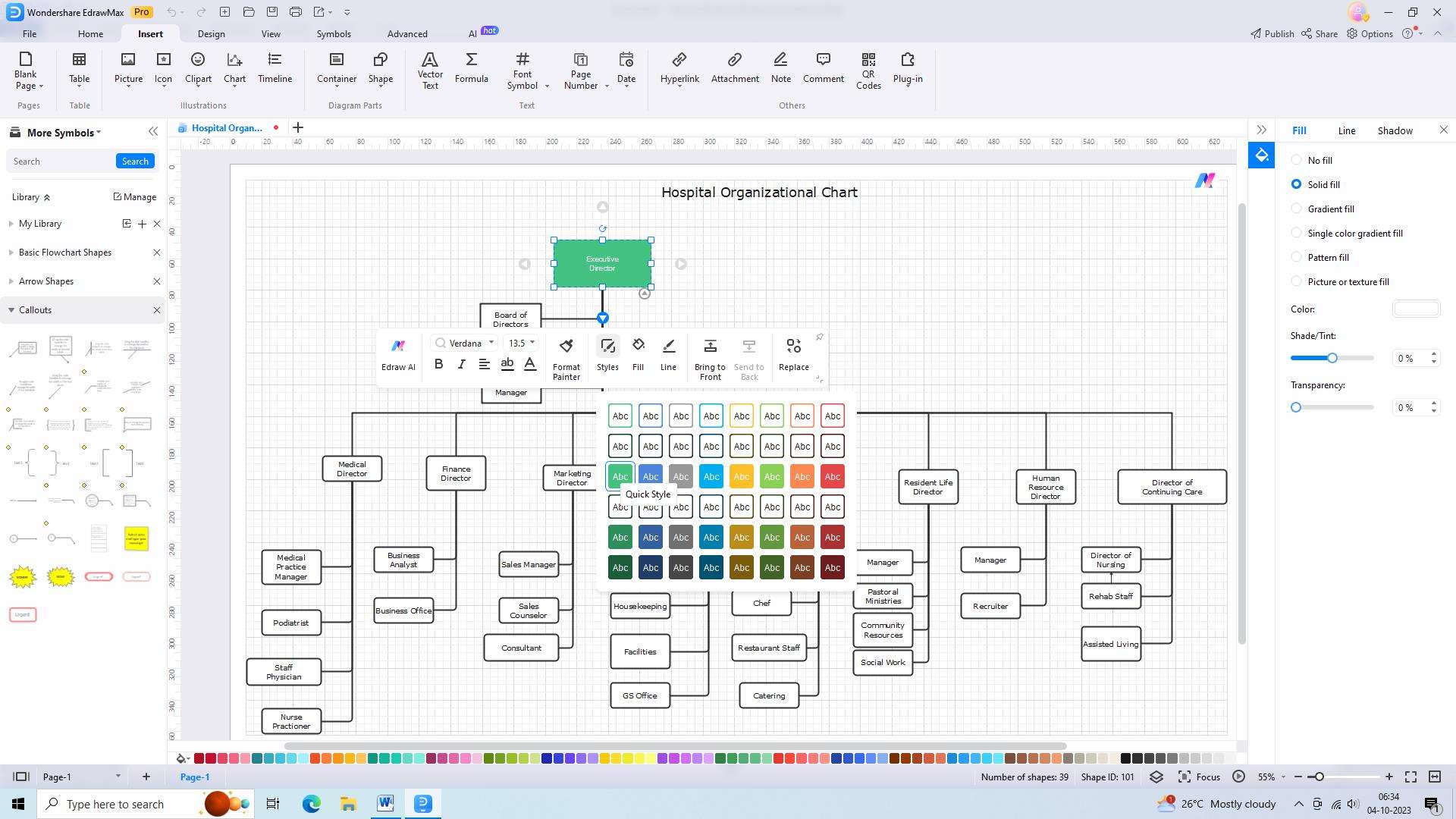
Step 5: Rearrange and Connect Shapes
Drag and drop shapes to create a logical structure, showing reporting relationships and connections between departments and positions.
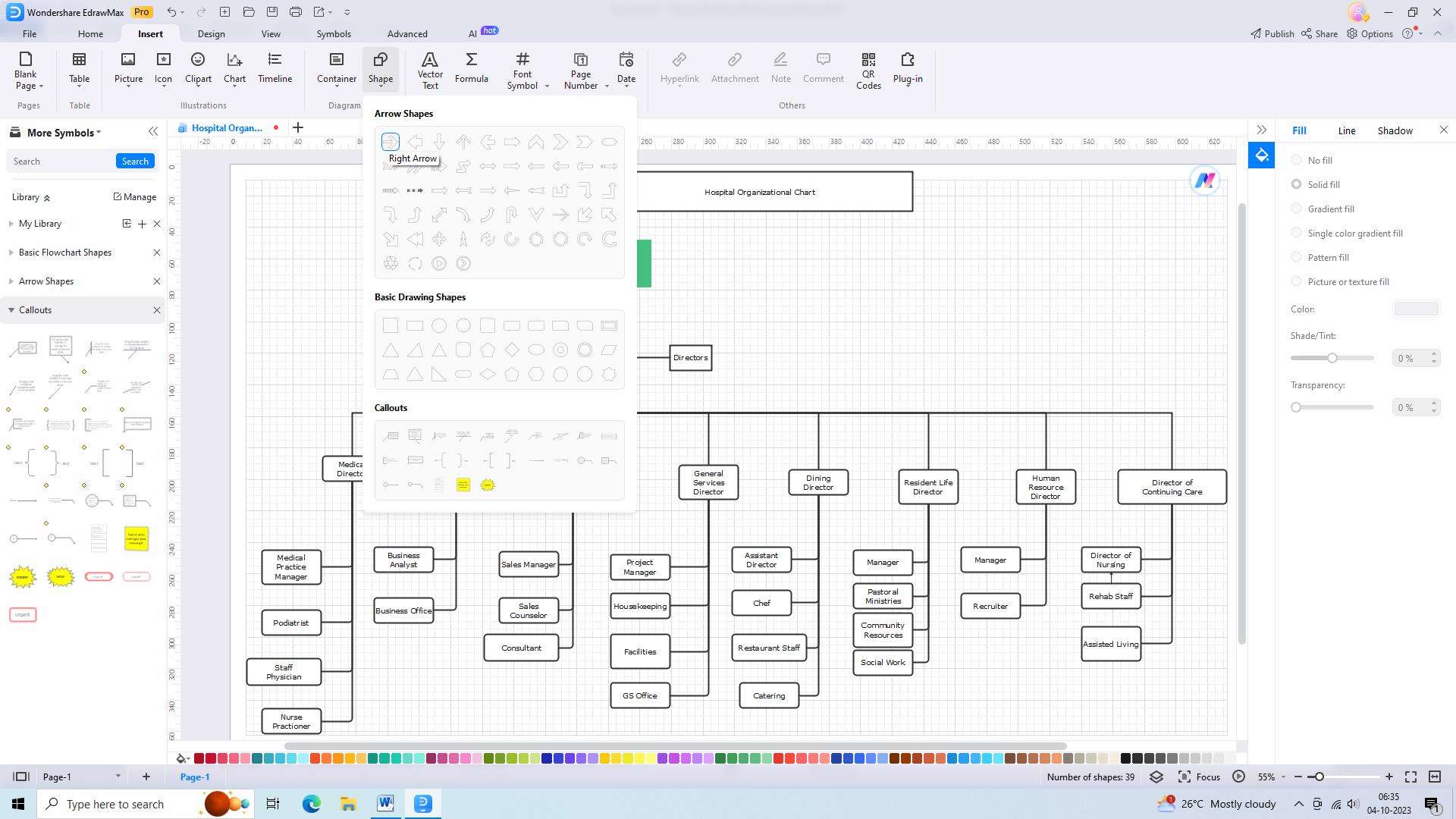
Step 6: Enhance Visual Appeal
Enhance the visual appeal of your hospital hierarchy chart. Experiment with different colors, fonts, and styles to create a visually appealing and easily understandable hospital organizational chart.

Step 7: Export the Organizational Chart
Wondershare EdrawMax lets you export charts in various formats. Select the option to export the organizational chart as a file, such as a PDF or an image file.
2) Pingboard
Pingboard is a user-friendly chart creation tool that simplifies the process for hospitals. It provides dynamic and interactive charts, allowing for easy navigation and access to employee information. Plus, it integrates with other HR systems, so the chart remains up-to-date. Additionally, it offers robust search and filter options for efficient chart management.

Features:
- Pingboard seamlessly integrates with popular HR systems, such as BambooHR and Namely, to automatically update the organizational chart with real-time employee data.
- Pingboard allows administrators to define specific access levels and permissions for different users, ensuring data security and privacy.
- Employee engagement features: Pingboard offers features like employee recognition and feedback tools, fostering a culture of engagement and collaboration within the hospital.
Pros:
- Pingboard utilizes artificial intelligence algorithms to automatically generate an initial organizational chart based on employee data, saving time and effort in the initial setup.
- Pingboard provides in-depth analytics and reporting capabilities, allowing hospitals to gain valuable insights into their organizational structure and make data-driven decisions.
- Pingboard offers features like instant messaging and onboarding checklists, facilitating smooth communication and streamlined onboarding processes.
Cons:
- While Pingboard offers customization options, it may have limitations when it comes to creating complex organizational charts with multiple levels and intricate hierarchies.
- Pingboard primarily operates as a web-based platform, which means users may face challenges accessing and editing the organizational chart without an internet connection.
- As Pingboard integrates with HR systems and stores employee data, there may be concerns regarding data privacy and security, especially for hospitals with strict compliance requirements.
3) Venngage
Venngage is a versatile chart creation tool that offers hospitals a variety of customization options. It has a wide range of templates, icons, and design elements to create visually engaging charts. Furthermore, users can import data from spreadsheets or other sources, making it easy to update and maintain organizational charts.

Features:
- Venngage provides a user-friendly drag-and-drop editor, allowing users to easily create and customize hospital organizational charts without needing any design skills.
- Venngage offers a wide range of data visualization options, such as charts and graphs, to present complex information in a visually engaging manner within the organizational chart.
- Venngage allows users to incorporate their hospital's branding elements, such as logos and color schemes, to create a customized and cohesive organizational chart.
Pros:
- Venngage provides a comprehensive collection of healthcare-specific icons, images, and visuals, enabling users to create visually appealing and relevant hospital organizational charts.
- Venngage offers collaboration tools like commenting and feedback options, making it easy for teams to collaborate and make improvements to the organizational chart.
- Venngage allows users to export the organizational chart in various formats, including PDF and PNG, for easy sharing and printing.
Cons:
- Venngage may have limitations when it comes to customizing the layout of the organizational chart, particularly for hospitals with complex structures or unconventional reporting relationships. Users may find it challenging to achieve the desired visual representation.
- While Venngage allows data import from external sources, it may not offer advanced integration capabilities with specialized hospital software or systems, limiting the ability to automatically sync and update the organizational chart with real-time data.
- Venngage's design capabilities and visual elements may require significant system resources, making it potentially slower or less efficient when creating and editing organizational charts for large hospitals with a large number of employees and departments.
Conclusion
Hospital organizational charts are vital tools in establishing and maintaining efficient hospital management systems. They offer a visual representation of the organizational structure and the roles and responsibilities of staff members. The significance of having a well-structured and updated organogram of hospital cannot be overstated.




